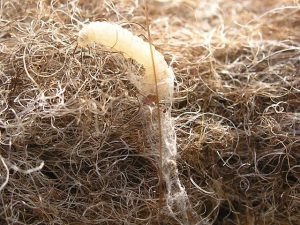Moth Damage: Signs Your Rug Has Been Eaten by Moths
You notice that your beautiful rug seems a bit worn or even bare in some places, but not in others. Could this be a sign that moths have started eating your rug?
Quite possibly.
But what if you notice moths flying around and underneath your carpet? Does that mean your rug is a goner?
Possibly, but there’s still hope.
Knowing that your rug is being eaten by moths can be hard to ascertain with any certainty. So we’ve put together a few signs that your rug truly has become a buffet for these pests.
- Moths flying around your rug could be a sign of moth infestation, but not always.
This is because adult moths don’t eat wool fibers; their offspring do (when they are in larval form). A female lays her eggs where she feels her children will have easy access to food (wool), so she often chooses wool clothing and wool rugs/carpets. Once the eggs hatch as larvae, they immediately begin to eat the wool fibers.
So those moths flying near your rug aren’t the ones eating its fibers, but their very presence could be a sign it’s time to turn a rug over and check for eggs or larvae.

Moth larvae love to eat wool fibers.
- You turn the rug over and see small white larvae.
Larvae on your rug are a sure sign your rug has been – or soon will be – attacked by moths. You also may see small round eggs nestled in your rug’s fibers (they are very small; the wriggling larvae will be easier to see). You may see no adult moths at all: the females have laid their eggs in a spot with plenty of food; their job is done and they have left.
You can suck the eggs/larvae up with your vacuum cleaner’s suction attachment to rid the rug of the larvae/eggs. We do recommend that you get the rug to a professional Oriental/Persian rug cleaner as soon as possible to make sure that all eggs/larvae are removed.
- The eggs/larvae rarely sit on top of the rug; females prefer to lay their eggs in dark, moist places.
That’s why it’s important that you check the rug’s backside for signs of eggs/larvae. This also is why it’s also important to move the rug from under furniture regularly, or at least rotate the rug so that every side spends some time – but not too much time – under the couch/table (rotate a rug about every two to three months).
- You don’t have to check the rug’s back: you notice bald spots on the top side of your rug.
This is a sign that larvae have been eating your rug’s fibers for a good long while and have been able to eat their way from the rug’s back to its front.
If this is the case, you’ll definitely need to get the rug to a professional rug cleaner to rid it of all larvae and to repair/restore the rug’s fibers (re-weaving it, if possible). Many Oriental and Persian rug cleaning services offer rug restoration services.
Persian Rug Cleaner of Dallas can rid your rug of larvae as well as repair/restore it when the larvae have had a chance to eat away some of its area. Contact us at 972-447-9600 for more information.
Image by Guido Gerding [GFDL or CC-BY-SA-3.0], via Wikimedia Commons

